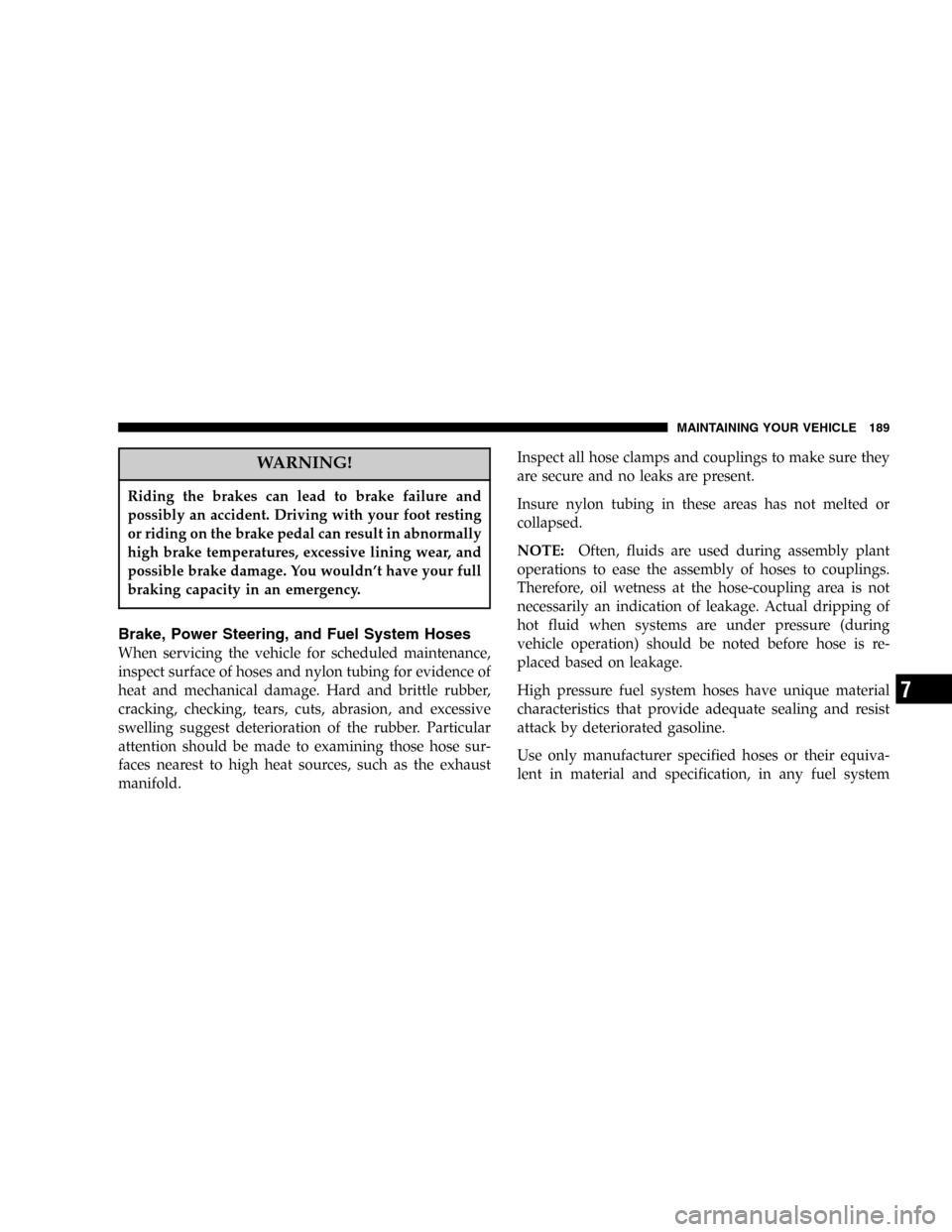Page 158 of 264

▫Body Lubrication.....................179
▫Front And Rear Suspension Ball Joints......179
▫Steering Linkage......................180
▫Body Mechanism Lubrication.............180
▫Windshield Washers...................182
▫Exhaust System......................182
▫Cooling System.......................183
▫Hoses And Vacuum/Vapor Harnesses.......188
▫Brake System........................188
▫Brake, Power Steering, And Fuel System
Hoses.............................189
▫Brake And Clutch Fluid.................190
▫Master Cylinder......................191▫Hydraulic Clutch.....................192
▫Transmission........................193
▫Rear Axle...........................193
▫Wheel Bearings.......................194
▫Appearance Care.....................194
�Fuses—Power Distribution Center..........197
�Vehicle Storage........................202
�Replacement Bulbs......................204
▫Interior Light Bulbs....................204
▫Exterior Light Bulbs...................205
�Exterior Light Bulb Service................205
▫Headlight, Parking, Front Park, Turn Signal, Front
Sidemarker And Front Fog Light Removal....205
158 MAINTAINING YOUR VEHICLE
Page 189 of 264

WARNING!
Riding the brakes can lead to brake failure and
possibly an accident. Driving with your foot resting
or riding on the brake pedal can result in abnormally
high brake temperatures, excessive lining wear, and
possible brake damage. You wouldn’t have your full
braking capacity in an emergency.
Brake, Power Steering, and Fuel System Hoses
When servicing the vehicle for scheduled maintenance,
inspect surface of hoses and nylon tubing for evidence of
heat and mechanical damage. Hard and brittle rubber,
cracking, checking, tears, cuts, abrasion, and excessive
swelling suggest deterioration of the rubber. Particular
attention should be made to examining those hose sur-
faces nearest to high heat sources, such as the exhaust
manifold.Inspect all hose clamps and couplings to make sure they
are secure and no leaks are present.
Insure nylon tubing in these areas has not melted or
collapsed.
NOTE:Often, fluids are used during assembly plant
operations to ease the assembly of hoses to couplings.
Therefore, oil wetness at the hose-coupling area is not
necessarily an indication of leakage. Actual dripping of
hot fluid when systems are under pressure (during
vehicle operation) should be noted before hose is re-
placed based on leakage.
High pressure fuel system hoses have unique material
characteristics that provide adequate sealing and resist
attack by deteriorated gasoline.
Use only manufacturer specified hoses or their equiva-
lent in material and specification, in any fuel system
MAINTAINING YOUR VEHICLE 189
7
Page 190 of 264
servicing. It is mandatory to replace all clamps that have
been loosened or removed during service.
NOTE:Inspection of brake hoses should be done when-
ever the brake system is serviced and at every engine oil
change. If there is any evidence of cracking, scuffing, or
worn spots, the hose should be replaced immediately!
Eventual deterioration of the hose can take place with
possible burst failure.Brake and Clutch Fluid
These fluids will tend to absorb moisture from the
atmosphere over a period of time. If the fluid becomes
contaminated with water, brake or clutch performance
will deteriorate. The brake and clutch fluid must be
changed every two years.
Clutch Fluid Reservoir
190 MAINTAINING YOUR VEHICLE
Page 191 of 264
CAUTION!
Brake fluid can damage the finish of your Viper. Do
not allow brake fluid to contact any painted surface.
WARNING!
Overfilling the brake fluid reservoir can result in
spilling brake fluid on hot engine parts and the
brake fluid catching fire.
Master Cylinder
The fluid level in the master cylinder should be checked
when performing underhood services, or immediately if
the brake system warning lamp shows system failure. Be
sure to clean the top of the master cylinder area before
removing the cap. If necessary, add fluid to bring the
Brake Fluid Reservoir
MAINTAINING YOUR VEHICLE 191
7
Page 192 of 264

fluid level up to the requirements described on the brake
fluid reservoir. With disc brakes, fluid level can be
expected to fall as the brake pads wear. However, low
fluid level may be caused by a leak and a checkup may be
needed. Use only the manufacturer’s recommended
brake fluid. Refer to the Recommended Fluids, Lubri-
cants and Genuine Parts section for the correct fluid type.
Mopar Brake Fluid is fluid of this quality and is recom-
mended to provide best brake performance. Use of a
brake fluid that may have a lower initial boiling point or
unidentified as to specification, may result in sudden
brake failure during hard prolonged braking.
Use only brake fluid that has been in a tightly closed
container to avoid contamination from foreign matter.Hydraulic Clutch
The fluid in the clutch master cylinder should be checked
when performing other under hood services. To check
the fluid level, remove the reservoir cap. If necessary, add
fluid to the reservoir. Use only the manufacturer’s rec-
ommended brake fluid. Refer to the Recommended Flu-
ids, Lubricants and Genuine Parts section for the correct
fluid type. Mopar brake fluid is fluid of this quality and
is recommended to provide best brake performance.
Make sure that the fluid has been stored in a tightly
closed container to avoid contamination with dirt or
moisture. Do Not Overfill. Overfilling can cause clutch
release problems as the clutch wears. A low fluid level
may indicate a leak, in which case, hydraulic clutch
linkage replacement may be required. The fluid level in
the reservoir will rise as the clutch wears - Do Not
Remove Fluid.
Do not allow petroleum base fluid to contaminate the
brake fluid—seal damage will result.
192 MAINTAINING YOUR VEHICLE
Page 214 of 264
Chassis
Component Fluid, Lubricant, or Genuine Part
Transmission Mopar Synthetic Manual Transmission Lubricant SAE 75W-85 (Castrol Syn-
torq LT 75W/85)
Rear Axle Mopar Synthetic Gear and Axle Lubricant SAE 75W-140, with Limited Slip
Additive Friction Modifier
Brake Master Cylinder Mopar�Brake & Clutch Fluid DOT 4 Motor Vehicle
Power Steering Reservoir ATF+4
214 MAINTAINING YOUR VEHICLE
Page 215 of 264
Body
Component Fluid, Lubricant, or Genuine Part
Hinges:
Door, Trunk & Hood Springs and
LinksMopar�Spray White Lube
Latches:
Door, Hood & Trunk Mopar�Multi-Purpose Lube NLGI Grade 2
Door Hinge Check Spring Lubriplate Mo-Lith No. 2 Grease or Petrocan Multiflex Moly EP 2 Grease
Seat Regulator & Track Mopar�Multi-Purpose Lube NLGI Grade 2
Window System Components Mopar�Spray White Lube
Lock Cylinders Mopar�Spray White Lube
Parking Brake Mechanism Mopar�Spray White Lube
MAINTAINING YOUR VEHICLE 215
7
Page 220 of 264

At Each Stop for Fuel
•Check the engine oil level about 5 minutes after a fully
warmed engine is shut off. Checking the oil level while
the vehicle is on level ground will improve the accu-
racy of the oil level reading. Add oil only when the
level is at or below the ADD or MIN mark.
•Check the windshield washer solvent and add if
required.
Once a Month
•Check tire pressure and look for unusual wear or
damage.
•Inspect the battery and clean and tighten the terminals
as required.
•Check the fluid levels of coolant reservoir, brake
master cylinder, power steering and transmission and
add as needed.
•Check all lights and all other electrical items for correct
operation.
At Each Oil Change
•Change the engine oil filter.
•Inspect the exhaust system.
•Inspect the brake hoses.
•Inspect the suspension components.
•Lubricate door hinges and check springs.
•Check the engine coolant level, hoses, and clamps.
•Check power steering fluid level.
220 MAINTENANCE SCHEDULES
8
M
A
I
N
T
E
N
A
N
C
E
S
C
H
E
D
U
L
E
S